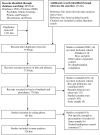Gender-Differentiated Parenting Revisited: Meta-Analysis Reveals Very Few Differences in Parental Control of Boys and Girls
- PMID: 27416099
- PMCID: PMC4945059
- DOI: 10.1371/journal.pone.0159193
Gender-Differentiated Parenting Revisited: Meta-Analysis Reveals Very Few Differences in Parental Control of Boys and Girls
Abstract
Although various theories describe mechanisms leading to differential parenting of boys and girls, there is no consensus about the extent to which parents do treat their sons and daughters differently. The last meta-analyses on the subject were conducted more than fifteen years ago, and changes in gender-specific child rearing in the past decade are quite plausible. In the current set of meta-analyses, based on 126 observational studies (15,034 families), we examined mothers' and fathers' differential use of autonomy-supportive and controlling strategies with boys and girls, and the role of moderators related to the decade in which the study was conducted, the observational context, and sample characteristics. Databases of Web of Science, ERIC, PsychInfo, Online Contents, Picarta, and Proquest were searched for studies examining differences in observed parental control of boys and girls between the ages of 0 and 18 years. Few differences were found in parents' use of control with boys and girls. Parents were slightly more controlling with boys than with girls, but the effect size was negligible (d = 0.08). The effect was larger, but still small, in normative groups and in samples with younger children. No overall effect for gender-differentiated autonomy-supportive strategies was found (d = 0.03). A significant effect of time emerged: studies published in the 1970s and 1980s reported more autonomy-supportive strategies with boys than toward girls, but from 1990 onwards parents showed somewhat more autonomy-supportive strategies with girls than toward boys. Taking into account parents' gender stereotypes might uncover subgroups of families where gender-differentiated control is salient, but based on our systematic review of the currently available large data base we conclude that in general the differences between parenting of boys versus girls are minimal.
Conflict of interest statement
Figures
References
-
- Wood W, Eagly AH. Biosocial construction of sex differences and similarities in behavior In Olson JM, Zanna MP, editors. Advances in Experimental Social Psychology, Vol. 46 Burlington: Academic Press; 2012. pp. 55–123.
-
- Bem SL. Gender schema theory: a cognitive account of sex typing. Psychol Rev. 1981;88: 354–364. 10.1037/0033-295X.88.4.354 - DOI
-
- Bem SL. Gender schema theory and its implications for child development: Raising gender-aschematic children in a gender-schematic society. Signs (Chic). 1983;8: 598–616.
Publication types
MeSH terms
LinkOut - more resources
Full Text Sources
Other Literature Sources
Medical
Miscellaneous



